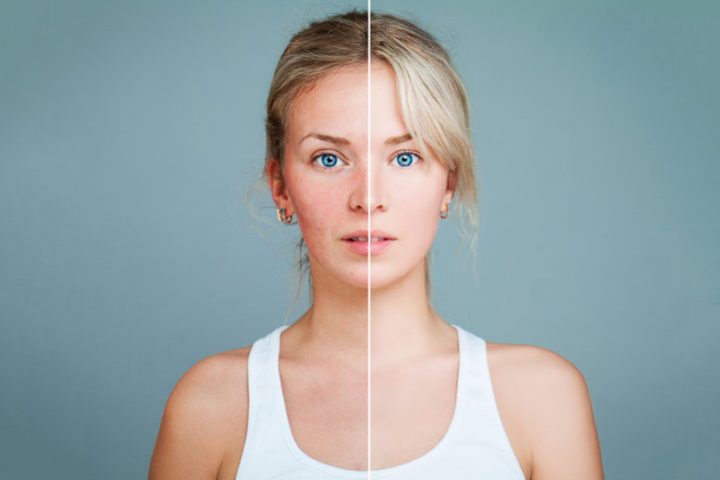
Rosacea is an extremely common condition affecting a huge sector of the population. It is most common amongst women between 25 and 60 years of age, however it can occur to both men and women at any stage of life. Rosacea is a chronic inflammation of the skin and typically occurs in the fair-skinned category. It is often referred to as ‘the curse of the celts’. However many Asian clients also suffer from this condition. Rosacea is a chronic condition which is treatable but not curable. It may be controlled by certain products and lifestyle choices.
There are four classes of rosacea and they can be categorised as:
- Red face and flushing, sometimes developing into a constant redness around the nose or cheek area. It is usually symmetrical and gives a ‘butterfly’ effect.
- Red bumps or fluid-filled lesions (like acne) that can occur with or without the red face or flushing
- Rosacea of the eyes (ocular rosacea) usually occurs before the skin changes. The skin may experience a burning sensation and the eyes and eyelids may begin to redden and become sore. This an advanced form of Rosacea.
- Rhinophyma of the nose involves a slow enlargement of the oil glands which thickens the skin on and around the nose. This is more common in men and is often confused with alcoholism.
Typical rosacea symptoms can include:
- Persistently red cheeks
- Small, visible facial blood vessel/s
- Small red bumps on the face
- Burning sensation or uncomfortable eyes (advanced)
- Red, bulbous nose (advanced)
Rosacea occurs when there is an abnormal increase in blood flow to the face. Some factors that can contribute to worsening the condition include:
- Hot drinks
- Spicy foods
- Excess sunlight (especially without sun protection)
- Alcohol
- Exercising intensely
- High weather temperatures
- Hot baths/saunas
- Emotional stress
For more information on what foods and ingredients to avoid, read my blog post ‘Is Your Diet Inflaming Your Sensitive Skin or Rosacea?’ here
The stages of rosacea?
Rosacea is characterized by facial redness, particularly on the cheeks and nose. The condition usually occurs in stages.
In the early stages the individual will notice frequent blushing. this often occurs as a child. The flushing then becomes more common and may become permanent. The face may have diffuse redness or there may be visible blood vessels (telangiectasia) present.
Rosacea may progress to a condition called acne rosacea whereby the individual suffers from small red bumps. This looks like acne but there are no blackheads or whiteheads evident and if squeezed and clear fluid exudes.
If left untreated, Rosacea may progress to a conditon called rhinophyma where the nose becomes red and bulbous. It may also affect the eyes in advanced cases.
So what can you do to help control your Rosacea?
- Use the best makeup to provide effective camouflage! Synergie Minerals Redness Correct camouflage will remove visible redness for the entire day.
- For foundation, pure mineral makeup containing high levels of zinc oxide is recommended (such as Synergie Minerals Second Skin Crush)
- Use ÜberZinc every day! It is your daily moisturizer and sun protection and will save your skin from UVA and UVB trauma which will contribute to the inflammation. Zinc oxide is also a natural anti-inflammatory.
- Vitamin B serum is effective for increasing the strength of the skin and reducing inflammation
- Ultimate A regulates the formation of healthy blood vessels. Stabilised retinol in Ultimate A serum is the gentlest and most effective way of delivering vitamin A to the skin.
- Avoid hot drinks and spicy foods which may increase the blood flow in your face
- Avoid facial products that contain irritants such as SLS, camphor, sorbic acid or alcohol which may irritate the skin and worsen the condition
- Try DermaCalm anti-redness moisturiser has be specifically formulated to calm irritated skin prone to redness and flushing.
- Apply De-Stress oil as your moisturiser in the evening. Pure olive Squalene and seabuckthorn oil is excellent for calming irritated skin.
- Reduce stress levels as best you can!
The following clinical treatments may be recommended to control Rosacea:
- PDT (Photo dynamic therapy) using blue light therapy and 5ALA (amino levulinic acid) in severe cases such as acne rosacea
- IPL or Laser targeting abnormal blood vessels and diffuse redness
- LED (light emitting diode) cold light therapy. This is a very gentle treatment and recommended for chronically inflamed skin
If you feel you may be suffering from rosacea, it is best to consult a skin professional for a correct diagnosis. It is important to commence treatment for this condition before it progresses.
THE ROUTINE:
DAY
- Cleansing Dust – gentle exfoliating cleansing powder
- Vitamin B – essential niacinamide serum
- DermaCalm – anti-inflammatory moisturiser
NIGHT
- Cleansing Dust – gentle exfoliating cleansing powder
- Ultimate A – stabilised retinol serum
- Vitamin B – essential niacinamide serum
- De-Stress – calming facial oil
OCCASIONAL
- Luciderm – acid-free exfoliating serum. Use every few days (PM) for clients needing extra exfoliation.
For an introductory set, we recommend the Synergie Skin Anti-Redness Kit, a soothing solution for addressing skin redness and rosacea.
